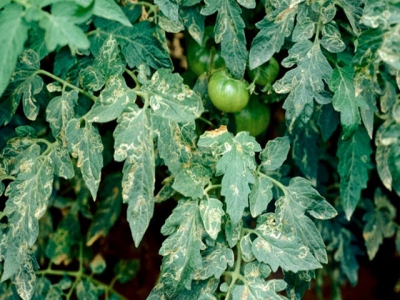Managing leaf miners in tomato crops

Leaf miners need not be the threat they were when originally introduced.
The ideal situation. The odd leaf miner here and there keeps the minute parasitic wasps in balance.
The first to arrive was the American serpentine leaf miner (Liriomyza trifolii). It attacks many crops, including a wide range of weeds, and has a penchant for tomatoes. It is a big problem in warm areas especially. The fact that it has such a wide range of hosts is actually an advantage, though. When it breeds in weeds, this leaf miner also becomes host to a number of parasitoids. These are perfectly able to keep the numbers down in most cases. So where L. trifolii enters a host crop land together with the parasitic wasps, they have the capacity to control it.
The South American leaf miner (Liriomyza huidobrensis), also known as the pea leaf miner, was accidentally introduced here a number of years later. As with the American leaf miner, this species has a wide crop range. When it first arrived, it attacked my pumpkins, laying eggs on the dicotyledonous leaves. The larvae then tunnelled down the stems and killed off many plants. The leaf miners also got into my beans and would have destroyed the crop if I hadn’t intervened. By the time it started to attack my tomatoes, I had wised up to getting it under control.
Life cycle
The American leaf miner likes warmer conditions, while L. huidobrensis prefers a more temperate climate. Both species can be active in the same area. The adult American leaf miner is the smaller of the two flies. Both are dark with a conspicuous yellow dot on the back. The American leaf miner makes an irregular ‘serpentine’ track all over the leaves. This track gets ever wider as the larva grows while feeding on the tissue between the upper and lower epidermis of the leaf.
The South American leaf miner, meanwhile, gravitates towards the midrib of the leaf, where it prefers to feed. The life cycle is very rapid in warm conditions and can be completed in up to 17 days. Leaf miners can thus become a major threat in a very short period. Puncture marks can be seen on the leaves as white specks. These are made with the ovipositor and an egg can be deposited here, but most are used for feeding on the sap.
When these leaf miners first arrived, they were devastating, as they were resistant to a number of insecticides. The more modern formulations were effective, but their rapid life cycle enabled the leaf miners to build up resistance rather quickly where farmers didn’t rotate the chemical group used for the pest.
Many of the effective products were also found to be toxic to the parasitic wasps which naturally control the miners. It turned out that the most effective route is to adopt an integrated approach using insecticides which do little or no harm to the parasitoids and yet bring the leaf miner population to a manageable level. In most cases, you will be able to get sufficient control by parasitoids alone.
Very careful
You may start off with a leaf miner problem and, by adopting this approach, have the problem completely under control later on. It becomes more difficult when you need to control a host of other pests which are partial to the crop. You then need to be very careful that you use parasitoid-safe products. Before this pest even arrived, through experience, farmers had learned not to use pyrethroids to control caterpillars on their tomatoes as this would often cause a flare-up of spider mites which were kept under control by their natural enemies which were taken out by pyrethroids.
And yet there are exceptions. I once visited a farmer and, while waiting for him to finish a task, examined his crop. I noticed that he had a very healthy population of parasitoids.When he joined me, I remarked that I could see he used very safe products for caterpillar control. He replied that he’d been using the same pyrethroid for many years. Not even knowing they existed, he’d unwittingly bred a resistant population of parasitoids. To sum up: the ideal scenario is to have a low number of leaf miners to sustain a population of parasitoids at this level.
Có thể bạn quan tâm
Phần mềm

Phối trộn thức ăn chăn nuôi

Pha dung dịch thủy canh

Định mức cho tôm ăn

Phối trộn phân bón NPK

Xác định tỷ lệ tôm sống

Chuyển đổi đơn vị phân bón

Xác định công suất sục khí

Chuyển đổi đơn vị tôm

Tính diện tích nhà kính

Tính thể tích ao hồ



 Bacterial diseases in tomatoes
Bacterial diseases in tomatoes  8 Indoor Crops for Winter Gardening
8 Indoor Crops for Winter Gardening